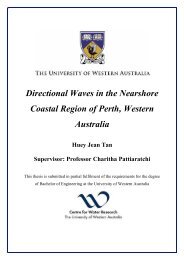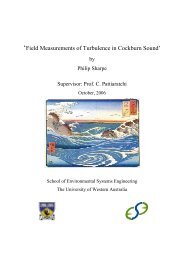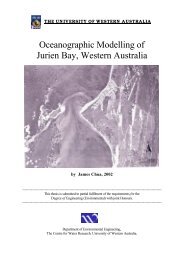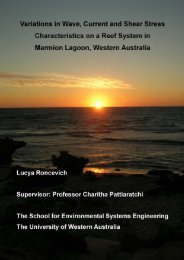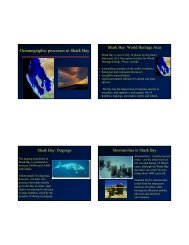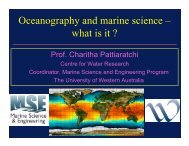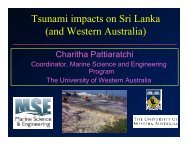Antarctic Oceanography
Antarctic Oceanography
Antarctic Oceanography
You also want an ePaper? Increase the reach of your titles
YUMPU automatically turns print PDFs into web optimized ePapers that Google loves.
Objectives<br />
<strong>Antarctic</strong> <strong>Oceanography</strong><br />
• What defines the <strong>Antarctic</strong> Region and Southern Ocean<br />
• What are the main surface currents in the region <br />
• What are the primary water masses<br />
– What are their T, S characteristics<br />
– Where/how are they formed<br />
• Why is North Atlantic Deep Water important for the<br />
region<br />
• What are the major frontal systems and how are they<br />
connected to the various water masses<br />
Ocean Fronts<br />
• Sharp boundaries between water masses<br />
• Large gradient between T & S or both across<br />
front<br />
• Can be caused by many processes:<br />
– FW runoff from rivers<br />
– Boundaries of ocean currents<br />
– Regions of subsurface convergences<br />
• Important for biological impacts, acoustics,<br />
eddy formation<br />
Cabbeling<br />
• When two water masses mix, because of the nonlinear dependence of<br />
density on temperature and salinity, the mixture is denser than either<br />
source.<br />
• Observed in <strong>Antarctic</strong>a when cold shelf water (formed during winter<br />
ice freezing) mixes with circumpolar deep water, becomes denser than<br />
either, and descends down the shelf slope to form AABW<br />
Increasing Temperature<br />
Surfaces of<br />
constant density<br />
ISW<br />
Increasing<br />
Density<br />
CDW<br />
AABW<br />
CDW<br />
ISW<br />
AABW<br />
Increasing Salinity<br />
Temperature (left) and Salinity (right) sections<br />
showing Cabbeling at 132 East in <strong>Antarctic</strong>a<br />
1
<strong>Antarctic</strong> Basins<br />
<strong>Antarctic</strong> Basins<br />
• Continent surrounded by ocean<br />
• Southern Ocean has free communication with all<br />
of world’s oceans – except the Arctic<br />
– Ocean basins 4000-6500 m deep<br />
– sills separating basins are about 3000 m deep<br />
– basins are essentially extensions of Atlantic,<br />
Pacific, and Indian Ocean Basins<br />
– no geographic impediment to water transport<br />
• Narrow and shallow shelf areas, with exception of<br />
Weddell and Ross Seas (400 m deep, 400 km wide<br />
shelves)<br />
The Southern Ocean<br />
The Southern Ocean<br />
• Southern Ocean is defined as area south of<br />
subtropical convergence (~40ºS), comprises ~23%<br />
of world’s ocean surface area<br />
• Area south of <strong>Antarctic</strong> Polar Front defines the<br />
polar water masses (~50-60ºS), comprises ~11%<br />
of world’s ocean surface area<br />
– volume is 11% of world total<br />
• Major mixing region for world’s water masses<br />
• Major source of deep water in global ocean<br />
• Driver of global thermohaline circulation<br />
2
<strong>Antarctic</strong><br />
Polar<br />
Front<br />
<strong>Antarctic</strong> Surface Currents<br />
Sub-<strong>Antarctic</strong><br />
Front<br />
Area in between<br />
is <strong>Antarctic</strong><br />
Polar Frontal<br />
Zone (APFZ)<br />
<strong>Antarctic</strong> Surface Currents<br />
Mean SLP in Southern Ocean<br />
South Polar High over the<br />
continent<br />
Symmetric low over<br />
Southern Ocean<br />
Statistical lows over<br />
Weddell and Ross Seas<br />
Surface currents are winddriven<br />
(though the gyres<br />
have a thermohaline<br />
component)<br />
3
<strong>Antarctic</strong><br />
Surface<br />
Currents<br />
• <strong>Antarctic</strong> Circumpolar<br />
Current<br />
• <strong>Antarctic</strong> Coastal<br />
Current<br />
<strong>Antarctic</strong> Surface Currents<br />
• <strong>Antarctic</strong> Circumpolar Current (ACC) (West Wind Drift)<br />
– Flows eastward, driven by westerly winds<br />
– Largest current on Earth, ~130 Sv (with max up to 290 Sv!),<br />
compared to 85 Sv for Gulf Stream, and ~7 Sv for Leeuwin<br />
Current<br />
– Northern limit of current defines the Southern Ocean (near<br />
subtropical convergence)<br />
– Fairly slow current (4-15 cm/s)<br />
– Extends very deep<br />
• Most currents extend only a few hundred meters<br />
• In Drake Passage, at 2500 m, current is 10-30% of surface<br />
current<br />
• Why<br />
<strong>Antarctic</strong> Circumpolar Current<br />
• Wind drives surface current eastward<br />
– Coriolis causes motion away from continent: sea surface slopes<br />
away from continent<br />
• Little stratification in <strong>Antarctic</strong><br />
– Vertical salinity and temperature gradients are small Pressure<br />
force due to horizontal density differences is distributed<br />
throughout water column (whereas in tropics much of it happens<br />
in the pycnocline)<br />
– Weak stratification allows transfer of momentum to lower water<br />
much more easily than for strong stratification<br />
– Therefore current is transmitted to great depths<br />
• Deep Current unimpeded all the way around continent – therefore<br />
water from Atlantic and Pacific and Indian Ocean is mixed well –<br />
<strong>Antarctic</strong>a is earth’s main mixing region<br />
<strong>Antarctic</strong> Surface Currents<br />
• <strong>Antarctic</strong> Coastal Current (not ACC!)<br />
(East Wind Drift)<br />
– Between ACC and continent - narrow<br />
– Opposite flow from ACC (polar easterlies)<br />
– Current speed ~0.1 m s-1, transport ~8 Sv<br />
– Current interrupted by <strong>Antarctic</strong> Peninsula<br />
and Ross Sea – forms gyres with ACC <br />
pushed Shackleton’s party away from coast<br />
4
Major <strong>Antarctic</strong> Water Masses<br />
<strong>Antarctic</strong> Region<br />
Major <strong>Antarctic</strong> Water Masses<br />
• Three Main layers (South of APFZ):<br />
– <strong>Antarctic</strong> Surface Water (AASW)<br />
– Circumpolar Deep Water (aka Warm Deep Water,<br />
aka <strong>Antarctic</strong> Circumpolar Water) (CDW or WDW or<br />
ACW)<br />
– <strong>Antarctic</strong> Bottom Water (AABW)<br />
• Other Water Masses<br />
– <strong>Antarctic</strong> Intermediate Water (AAIW) (North of APFZ)<br />
– Ice Shelf Water (ISF)<br />
Red lines are isotherms<br />
<strong>Antarctic</strong> Water Masses<br />
AASW<br />
<strong>Antarctic</strong> Surface Water (AASW): -1.9 to +4ºC, S < 34.5<br />
Ant. Circumpolar Water (ACW): 1.5-2.5ºC (top), 0-0.5ºC (bot.); S~34.7<br />
Ant. Intermediate Water (AAIW): 2-4ºC, S=34.2<br />
Ant. Bottom Water (AABW): -2.0ºC, S=34.75, very dense<br />
1. <strong>Antarctic</strong> Surface Water (AASW)<br />
– Between continent and <strong>Antarctic</strong> Polar Front (APF)<br />
– Cold (-1.9° to 4°C), relatively low salinity (S < 34.5<br />
ppt) in upper 50-200 m north of continental slope<br />
– Low salinity from fresh water input<br />
• Where does the fresh water come<br />
– Forms from deep water that has upwelled and<br />
modified by cooling and ice formation at the surface<br />
• North Atlantic Deep Water upwelling<br />
• Brings nutrients to surface – important for marine life<br />
– Influenced by ice melt and surface freezing<br />
5
<strong>Antarctic</strong> Water Masses<br />
2. Circumpolar Deep Water (CDW)<br />
– 1.5° to 2.5°C near surface, 0° to 0.5°C near bottom;<br />
salinity ~34.7 ppt<br />
– All around continent from just below surface to 4000<br />
m deep<br />
– Fairly uniform T-S properties around continent<br />
– Source is North Atlantic Deep Water (NADW)<br />
– Also called Warm Deep Water (esp. in Weddell<br />
Sea) and <strong>Antarctic</strong> Circumpolar Water<br />
<strong>Antarctic</strong> Water Masses<br />
3. <strong>Antarctic</strong> Bottom Water (AABW)<br />
– Formed in Weddell and Ross Seas<br />
– Mixture of shelf and CDW<br />
– Flows down slope into south Atlantic as<br />
bottom water below 4000 m (also into<br />
Pacific and Indian)<br />
– Traced to 40°N in Atlantic, 50°N in Pacific<br />
<strong>Antarctic</strong> Water Masses<br />
4. <strong>Antarctic</strong> Intermediate Water (AAIW)<br />
– 2-4°C, 34.2 ppt<br />
– Formed by AASW sinking at APF<br />
– Flows northward across equator at 800-<br />
1000 m deep (traced by high oxygen and<br />
salinity minimum)<br />
Spread of<br />
AAIW<br />
Blue numbers indicate<br />
depth of layer (m)<br />
Black numbers indicate<br />
salinity (ppt)<br />
6
<strong>Antarctic</strong> Water Masses<br />
Fronts and Zones<br />
5. Ice Shelf Water (ISW)<br />
– Formed when water on continental shelf comes in<br />
contact with Ice Shelves, melt them slightly and<br />
cools<br />
– -1.9 - -2.4°C, ~35 ppt<br />
– Coldest water on earth<br />
– Unique to <strong>Antarctic</strong>a<br />
– Source water is either brine rejected in coastal<br />
polynyas or CDW that has shoaled up onto the<br />
continental slope and circulates under the ice shelf<br />
North<br />
Sub-<strong>Antarctic</strong><br />
Zone<br />
Convergence<br />
Subtropical Sub<strong>Antarctic</strong> Polar<br />
Convergence Front Front<br />
<strong>Antarctic</strong><br />
Polar<br />
Frontal<br />
Zone<br />
<strong>Antarctic</strong><br />
Slope Front<br />
<strong>Antarctic</strong><br />
Zone<br />
Divergence<br />
Continental<br />
Zone<br />
Continent<br />
South<br />
<strong>Antarctic</strong> Fronts<br />
<strong>Antarctic</strong><br />
Polar Front<br />
zone<br />
Shaded region<br />
between<br />
<strong>Antarctic</strong> (Polar)<br />
Front and Sub-<br />
<strong>Antarctic</strong> Front is<br />
APFZ<br />
Both Fronts are<br />
characterized by<br />
strong jets<br />
7
<strong>Antarctic</strong> Fronts<br />
1. Continental Zone (CZ)<br />
– Shelf region between continent and <strong>Antarctic</strong> Zone<br />
– Southern boundary of <strong>Antarctic</strong> Zone called <strong>Antarctic</strong><br />
Slope Front (ASF)<br />
– Separates upwelling NADW from downwelling cold water<br />
off shelf<br />
2. <strong>Antarctic</strong> Zone (AZ)<br />
– ACC and Coast current flow in opposite directions<br />
– divergence (<strong>Antarctic</strong> Divergence at ~65°S)<br />
– Upwelling brings water from great depths (2500 m),<br />
compared to coastal upwelling<br />
– Important because it brings up NADW and nutrients for<br />
biological productivity<br />
Subtropical Subantarctic<br />
Conv. Front<br />
Subant. Zone APFZ<br />
x<br />
x<br />
40°S<br />
Vertical<br />
Cross-Section<br />
(looking east)<br />
AAIW<br />
NADW<br />
Ant. Polar<br />
Front<br />
50°S 60°S<br />
downwelling<br />
AZ CZ<br />
x • •<br />
AABW<br />
<strong>Antarctic</strong><br />
Slope Front<br />
upwelling<br />
70°S<br />
downwelling<br />
Surface<br />
Current<br />
<strong>Antarctic</strong>a<br />
N<br />
x-direction:<br />
x = into image<br />
(eastward)<br />
• = out of image<br />
(westward)<br />
y<br />
z<br />
<strong>Antarctic</strong> Fronts<br />
4. Subantarctic Zone<br />
– Northern edge of APFZ is the Subantarctic Front<br />
– North of front, lies the Subantarctic Zone<br />
– Water still moves with ACC<br />
– Edge of downwelling region<br />
– Northern limit is the Subtropical Convergence (~ 40° S), a<br />
region of very large temperature contrasts<br />
<strong>Antarctic</strong> Fronts<br />
3. <strong>Antarctic</strong> Polar Frontal Zone (APFZ)<br />
– Northern boundary of <strong>Antarctic</strong> Zone is called Polar Front<br />
or <strong>Antarctic</strong> Front<br />
– Northern boundary of APFZ is Sub-<strong>Antarctic</strong> Front<br />
– Region of surface convergence, thus downwelling<br />
– Where AAIW is formed<br />
– Incorporates main branch of ACC<br />
– First front found, originally called “<strong>Antarctic</strong> Convergence”<br />
– Position varies regionally and seasonally<br />
– Its position controls the northern limit of sea ice (upwelling<br />
brings warm water to surface which melts ice)<br />
8
Subtropical Subantarctic<br />
Conv. Front<br />
Subant. Zone APFZ<br />
x<br />
x<br />
40°S<br />
Vertical<br />
Cross-Section<br />
(looking east)<br />
AAIW<br />
NADW<br />
downwelling<br />
Ant. Polar<br />
Front<br />
50°S 60°S<br />
AZ CZ<br />
x • •<br />
AABW<br />
<strong>Antarctic</strong><br />
Slope Front<br />
upwelling<br />
70°S<br />
downwelling<br />
Surface<br />
Current<br />
<strong>Antarctic</strong>a<br />
N<br />
x-direction:<br />
x = into image<br />
(eastward)<br />
• = out of image<br />
(westward)<br />
y<br />
z<br />
Subtropical<br />
Front<br />
Subant. Zone<br />
Subantarctic<br />
Front<br />
APFZ<br />
Ant. Polar<br />
Front<br />
ACC ACC ACC<br />
40°S 50°S 60°S<br />
x – downwelling<br />
(convergence)<br />
• - upwelling<br />
(divergence)<br />
AZ<br />
AABW<br />
formation<br />
AAIW NADW<br />
formation upwelling<br />
x • x<br />
<strong>Antarctic</strong><br />
Slope Front<br />
Volume<br />
CZ transport<br />
Coastal<br />
70°S<br />
<strong>Antarctic</strong>a<br />
N<br />
E<br />
Overhead<br />
View<br />
Role of the Southern Ocean in Global<br />
Circulation<br />
• Major source of world’s bottom water<br />
– Bottom water circulates around <strong>Antarctic</strong> and<br />
penetrates into Atlantic, Pacific and Indian Oceans<br />
– Drives global thermohaline circulation<br />
• Bottom water formed primarily on <strong>Antarctic</strong> Shelves<br />
through density driven convection<br />
• Two processes for bottom water formation in <strong>Antarctic</strong>a<br />
– Coastal polynya<br />
– Cabelling<br />
9



